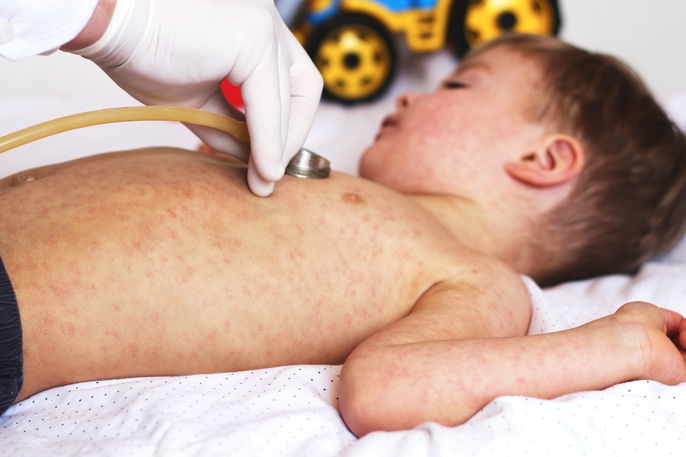Measles is a highly contagious viral disease causing symptoms like fever, persistent cough, runny nose, conjunctivitis, and a rash, which usually begins as small red spots that appear along the hairline before spreading down to the rest of the body. This rash is not typically itchy and does not cause discomfort.
Measles treatment involves managing symptoms while the body works to eliminate the virus. Supportive care includes rest, hydration, and eating light meals. It is important to consult your doctor or primary care provider for guidance, especially in the case of children, who may require vitamin A supplementation.
The best way to prevent measles is by getting the measles vaccine, which is included in the routine childhood vaccine schedule. The first dose of this vaccine (which is part of a combined vaccine called the MMR or MMRV) is recommended at 12 months of age. It can also be given to people of any age who were not vaccinated as children, in which case a single dose is typically recommended.

Main symptoms
The most common symptoms of measles include:
- Small red spots that first appear on the face and then spread down toward the feet (not typically itchy);
- Tiny white spots inside the mouth (Koplik spots);
- High fever;
- Productive cough;
- Conjunctivitis;
- Sensitivity to light;
- Runny nose;
- Loss of appetite.
Other symptoms may include headache, stomachache, vomiting, diarrhea, and muscle pain.
Measles symptoms can appear 8 to 12 days after coming into contact with the virus. Treatment should be started right away to help prevent complications.
Symptom checker
Use the symptom checker below to see if your symptoms could be caused by measles (select all that apply):
This symptom checker is only a tool and should not be used to diagnose any condition or take the place of a consultation with your doctor.
Confirming a diagnosis
Measles can be diagnosed by a healthcare provider based on an evaluation of symptoms, however a lab test is necessary to confirm the diagnosis and rule out other diseases that can present with similar symptoms.
Diagnostic testing for measles may involve a blood test, urine specimen, nasopharyngeal swab, and/or throat swab to check for specific antibodies against the measles virus (IgG and IgM), which is typically done using the ELISA technique.
PCR is another diagnostic technique used to detect the measles virus that can also measure viral load (the amount of virus in the body). PCR uses nasopharyngeal swabs, throat swabs, or urine specimens.
Transmission and spread
Measles is primarily spread through the air, which happens when an infected person coughs or sneezes, releasing respiratory droplets into the air containing viral particles capable of spreading the disease to others.
It is also possible to contract measles by coming into contact with contaminated surfaces, as the measles virus can survive on surfaces for up to 2 hours.
The highest rate of transmission occurs 2 days before to 2 days after the rash appears. This is when measles is the most contagious.
Treatment options
Measles treatment focuses on symptom relief and involves rest, hydration, and the use of fever-reducing medications. The World Health Organization (WHO) also recommends vitamin A supplementation for all children diagnosed with measles, which should be prescribed by a pediatrician or other healthcare provider based on the child's age. .
Most people with measles make a full recovery within about 10 days from onset of symptoms. Antibiotics may be needed if there is evidence of an associated bacterial infection, such as an ear infection or pneumonia, which are common complications of measles.
Possible complications
In the majority of cases, measles symptoms resolve on their own without any long term consequences, however people with a weakened immune system have a higher risk of developing complications such as airway obstruction, pneumonia, encephalitis, ear infections, blindness, and severe diarrhea that can result in dehydration.
For this reason, it is important to consult your primary care provider or an infectious disease specialist at the first sign of symptoms.
Prevention methods
The best way to prevent measles is by getting the measles vaccine, with the first dose recommended at 12 months of age. Other precautions that can help protect against the measles include:
- Frequent hand washing, especially after being around people who are sick;
- Avoiding touching your eyes, nose, or mouth (in case your hands are contaminated);
- Avoiding enclosed spaces with lots of people;
- Avoiding direct contact with people who are sick, including kissing, hugging, and sharing utensils.
Isolating the infected person can also help prevent spread of the disease, however the vaccine remains the only truly effective method.
People who are diagnosed with measles should rest at home and avoid going to work or school to help prevent spreading the disease to others. Close contacts (such as siblings) should be given the vaccine if not previously vaccinated.
Vaccine types
The measles vaccine is typically given as part of a combined vaccine, with the first dose given at 12 to 15 months of age and the second dose at 4 to 6 years of age. The two types of combined vaccines for measles are:
- MMR: protects against measles, mumps and rubella;
- MMRV: also protects against varicella (chickenpox).
The measles vaccine is indicated for all children as well as anyone who has not been previously vaccinated. For people who are not vaccinated and come into contact with measles, the vaccine should be given within 3 days of exposure in order to be effective.






























